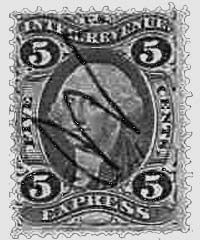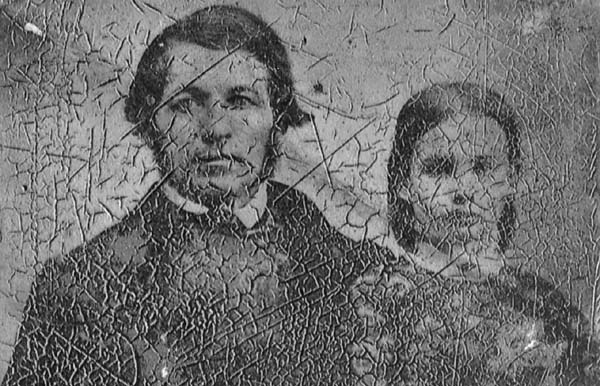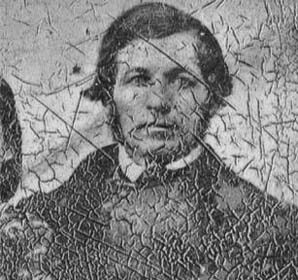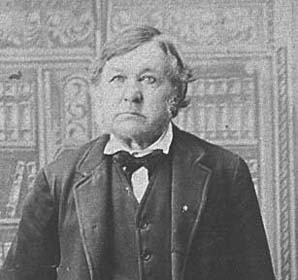A Boßecker Tintype
I recently received an email from Alvin B. [Born: 1941] and Audrey (Quick) Buss [Born: 1942] of Minneapolis, Minnesota.
Alvin is the GG-Grandson of the immigrant Johannes Boßecker and the Great-Grandson of Johannes’s daughter Antonie Caroline
(Bosecker) Kirsch.
Alvin and Audrey had been going through some of the effects of the late Elizabeth Ann “Betty” Buss [1935-1997] and had
discovered some old photographs in a small box.
The collection in the box consisted of several images, all labeled by George Valentine Kirsch Jr. [1872-1960]. Most of
the photos were of the Kirsch branch of the family with a few being from the Bosecker family. All of the images were
interesting but there was one tintype that stood out from all the rest.
This tintype was 3¼ inches tall and 2½ inches wide. It was very dark and was covered with cracks. On the back of the
tintype were a handwritten note and a US Tax Revenue stamp.
The note, written in pencil, was somewhat difficult to read. It looked like Grosfater Bosecker and meine mutter…
Grandfather Bosecker and my mother.
If George Valentine Kirsch Jr. had written this note, the images on this tintype were of the immigrant Johannes Boßecker
[1816-1896] and his oldest daughter Antonie Caroline (Bosecker) Kirsch [1841-1886].
I was pretty excited about this find! Caroline (Bosecker) Kirsch had been born in Germany. She had accompanied the
family from Germany when she was 5 years old and grown up in Adams County, Indiana. In 1859 she had married George
Valentine Kirsch Sr. [1837-1917]. Caroline had died 4 days after having given birth to her 9th child. There were no
known photographs of her.
Studying the image closely, Alvin, Audrey and I thought that the girl appeared to be young. Perhaps this was a photograph
taken on Caroline’s Confirmation Day. If that were the case, the tintype would have been taken around 9 Apr 1854. In
1854 Johannes would have been about 38 years old. This seemed consistent with the images we saw on the tintype.
How long, we wondered, had tintype photography existed. Were tintypes being made in 1854?
I did some research and discovered that Adolphe Alexandre Martin had introduced the tintype in 1853. This form of
photography became extremely popular in the United States by the 1860’s. The tintype remained popular until the late
1800’s when other photographic technologies superceded it.
It is not hard to see why the tintype was so popular.
- The process was simple enough to enable one to set up a photography business without much capital.
- It was much faster than other processes of the time. It was basically a one-step process.
- Cheap to produce, a tintype’s price was within the reach of most Americans.
- They were more durable than extremely fragile glass-based ambrotypes (the tintype’s predecessor) and could be safely
carried, sent in the mail or mounted in an album.
So tintypes might have been taken in the United States in the mid-1850’s. What about the stamp on the back of the tintype? Could it help to determine the approximate date the tintype was made?

It turns out the stamp on the back of the tintype dates the photograph to within a couple of years.
In 1862, the United States federal government instituted a series of stamp taxes on consumer goods to help pay for what
was rapidly becoming a very expensive war effort against the Confederacy.
The Civil War popularized photography to a new degree. Demand for cheap portraits grew rapidly as men marched off to war,
wishing to leave portraits behind or to take one with them. Many studios also did a brisk trade supplying images of the
scenes and heroes of the war.
This mass popularity did not escape the notice of the Treasury Department. Charged with raising as much money as possible
for the war, its fledgling Office of Internal Revenue levied a stamp tax in August 1864 on what it referred to as
“…photographs, ambrotypes, daguerreotypes, or any sun pictures".
The act required that the photographer cancel the stamp by initializing and dating it but most simply canceled with a
quick stroke of the pen. Stamps properly canceled can be valuable because the image can be precisely dated and the
photographer can be identified. The photographer that took the tintype of Johannes and Caroline canceled his stamp
by scratching a quick “#” in ink so no date information is available.
The amount of the tax was a function of the cost of the photograph. If the photograph cost 25¢ or less, the tax was 2¢.
If the photograph cost between 25¢ and 50¢, the tax was 3¢. A photograph that cost between 50¢ and $1.00 was taxed 5¢.
The stamp on this tintype was 5¢ so we can conclude that it cost less than a dollar. (This higher expense was probably the
result of a frame, which is no longer extant.)
Photographers, already burdened by duties on their raw materials, an income tax and a license fee, petitioned Congress
through trade organizations. These trade organizations argued that the photographer’s share of the National Debt was
already unfairly high and that the stamps ruined their pictures. After two years, their persistent efforts won out
and the stamp tax was lifted on August 1, 1866.
Thus the stamp on the tintype dated the photograph to the period of the Wartime Retail Tax Act; sometime between
September 1, 1864 and August 1, 1866.
1864 to 1866... This was about 10 years later than I had first guessed based upon the appearance of the people in the
photograph. I tried to imagine what Johannes, as a man in his late 40’s, and Caroline, as a young woman in her early
20’s, might have looked like and then I looked at the tintype again. I wasn’t happy with what I saw (they didn’t look
old enough) but perhaps the limitations of tintype photography, the very dark exposure and damage to the tintype had
produced an image that made the subjects look younger than they were.
In my files I had a copy of a photograph of Johannes that had probably been taken in the 1880’s. This photograph was
published in the 5th issue of The Boßecker Newsletter. I pulled out the image of the older Johannes and compared it
to the tintype. I called my wife over and asked what she thought. She immediately pointed out another problem.
The men parted their hair on different sides of their heads!
This observation, to me, was VERY bad news. While things could have been different in the late 1800’s, it just didn’t
seem likely (to me) that a man would change which side of his head he parted his hair on.
Some time later, while doing more research on tintype photography, I learned that tintype images were a mirror image of
reality. Images like the photograph of Johannes taken in the 1880’s were created from a negative and produce a “normal”
image. These two photographs were of men that DID part their hair on the same side and it was the images that were
reversed.
I scanned the image of the tintype and digitally “flipped” it so that it would no longer be a “mirror image”. I then
compared the “flipped” image to the photograph of Johannes taken in the 1880’s. This comparison, combined with the
high confidence I have in George Valentine Kirsch Jr.’s note on the back of the tintype, brings me to the conclusion
that this tintype really IS an image of Johannes Boßecker and his daughter, Antonie Caroline (Bosecker) Kirsch. (These
images are available for your comparison on page 4 of this issue.)
A Brief History of Photography
I thought it might be useful to include a very brief description of the various kinds of photographs that were produced in
the 1800’s and how this information can assist in dating an image.
DAGUERREOTYPE (1839 to about 1870)
The case resembled a double frame. The image was on a silver clad copper sheet that was attached to a sheet of glass
by a foil-like brass decorative frame. This sealed packet was then force fit into a special wood case and was often
padded with velvet or silk. Many times, the silver image tarnishes with silver sulfide in the same way as silverware.
CALOTYPE (1845 to about 1855)
The first photographs on paper. Calotypes were never widely popular, and most of those surviving are in museums.
AMBROTYPE (1854 to about 1865)
The ambrotype is a thin negative image on glass made to appear as a positive by showing it against a black background.
Similar to daguerreotype in appearance, it was common for the ambrotype to be colored. Buttons, watch chains, pendants,
broaches were often tinted with color.
TINTYPE (1853 to the early 20th Century)
Introduction - 1860. The earliest tintypes were on heavy metal (0.017 inches thick) that was never again used. They are
stamped "Neff's Melainotype Pat 19 Feb 56" along one edge.
Civil War Period 1861 - 1865. Tintypes of this time are often datable by their paper holders, adorned with patriotic
stars and emblems. After 1863 the paper holders were embossed rather than printed. Uncased tintypes have been found
with canceled tax stamps adhered to the backs. The stamps date these photographs to the time period previously mentioned
in this newsletter.
Brown Period 1870 - 1885. In 1870 the Phoenix Plate Co. began making plates with a brown-tinted surface.
Brown tintypes were almost exclusively used from 1870 to 1885.
THE CABINET CARD (1866 - 1906).
A card stock product, nearly four times the size of previous photographs on card stock.
Readers respond to the Last Issue’s Query
Several readers responded that the lady in question, in the last issue, was indeed Louise (Bosecker) Mohr [1854-1943].
Thanks to all for their help in this query.
|



